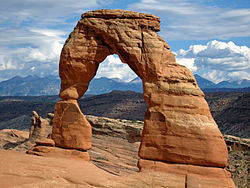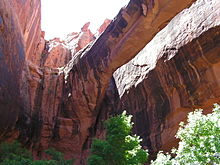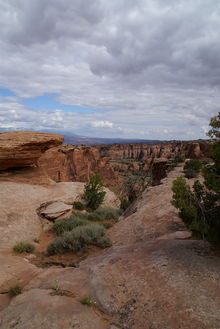- Moab, Utah
-
Moab, Utah — City — Delicate Arch in Arches National Park near Moab Location of Moab within Utah
Coordinates: 38°34′21″N 109°32′59″W / 38.5725°N 109.54972°WCoordinates: 38°34′21″N 109°32′59″W / 38.5725°N 109.54972°W Country United States State Utah County Grand Settled 1878 Incorporated 1902 Named for Moab Government - Type Mayor/city council - Mayor David Sakrison Area - Total 3.6 sq mi (9.4 km2) - Land 3.6 sq mi (9.4 km2) - Water 0.0 sq mi (0.0 km2) Elevation 4,026 ft (1,227 m) Population (2000) - Total 4,779 - Density 1,313.1/sq mi (507.0/km2) Time zone Mountain (MST) (UTC-7) - Summer (DST) MDT (UTC-6) ZIP code 84532 Area code(s) 435 FIPS code 49-50700[1] GNIS feature ID 1430389[2] Website www.moabcity.state.ut.us Moab is a city in Grand County, in eastern Utah, in the western United States. The population was 4,779 at the 2000 census. It is the county seat and largest city in Grand County.[3] Moab hosts a large number of tourists every year, mostly visitors to the nearby Arches and Canyonlands National Parks. The town is a popular base for mountain bikers who ride the extensive network of trails including the famed Slickrock Trail, and off-roaders who come for the annual Moab Jeep Safari.
Contents
History
The Biblical name Moab refers to an area of land located on the eastern side of the Jordan River. Some historians believe the city in Utah came to use this name because of William Pierce, the first postmaster, believing that the biblical Moab and this part of Utah were both "the far country".[4][5] However, others believe the name has Paiute origins, referring to the word "moapa" meaning mosquito.[6] Some of the area's early residents attempted to change the city's name because in the Christian Bible, Moabites are demeaned as incestuous and idolatrous. One petition in 1890 had 59 signatures and requested a name change to Vina.[7] Another effort attempted to change the name to Uvadalia.[6]
During the 1800s the area around what is now Moab served as the Colorado River crossing along the Old Spanish Trail. Mormon settlers attempted to establish a trading fort at the river crossing called "Elk Mountain Mission" in 1855 to trade with travelers attempting to cross the river. After repeated Indian attacks, the fort was abandoned in late 1855. A new round of settlers established a permanent settlement in 1878. Moab was incorporated as a town on December 20, 1902.[6]
In 1883 the Denver and Rio Grande Western Railroad main line was constructed across eastern Utah. The rail line did not pass through Moab, instead passing through the towns of Thompson Springs and Cisco, forty miles to the north.[8] Later, other places to cross the Colorado were constructed, such as Lee's Ferry, Navajo Bridge and Boulder Dam. These changes shifted the trade routes away from Moab. Moab farmers and merchants had to adapt from trading with passing travelers to shipping their goods to distant markets. Soon Moab's origins as one of the few natural crossings of the Colorado River were forgotten. Nevertheless, the U.S. military deemed the bridge over the Colorado River at Moab important enough to place it under guard as late as World War II.
Moab's economy was originally based on agriculture, but gradually shifted to mining. Uranium and vanadium were discovered in the area in the 1910s and 1920s. Potash and manganese came next, and then oil and gas were discovered. In the 1950s Moab became the so-called "Uranium Capital of the World" after geologist Charles Steen found a rich deposit of uranium ore south of the city.[6] This discovery coincided with the advent of the era of nuclear weapons and nuclear power in the United States, and Moab's boom years began.
The city population grew nearly 500% over the next few years, bringing the population to near 6,000 people. The explosion in population caused much construction of houses and schools. Charles Steen donated a great deal of money and land to create new houses and churches in Moab.
With the winding down of the Cold War Moab's uranium boom was over, and the city's population drastically declined. By the early 1980s a number of homes stood empty and nearly all of the uranium mines had closed.
In 1949, Western movie director John Ford was persuaded to use the area for the movie Wagon Master. Ford had been using the area in Monument Valley around Mexican Hat, Utah, south of Moab, since he filmed Stagecoach there 10 years earlier in 1939. A local Moab rancher found Ford and persuaded him to come take a look at Moab.[citation needed] There have been numerous movies filmed in the area since then, using Arches National Park and Canyonlands National Park as backdrops.
Since the 1970s tourism has played an increasing role in the local economy. Partly due to the John Ford movies, partly due to magazine articles, the area has become a favorite of photographers, rafters, hikers, rock climbers, and most recently mountain bikers. Moab is also an increasingly popular destination for four-wheelers as well as for BASE jumpers and those rigging Highlining, who are allowed to practice their sport in the area. Moab's population swells temporarily in the spring and summer months with the arrival of numerous people employed seasonally in the outdoor recreation and tourism industries.
In recent years Moab has experienced a surge of second-home owners. The relatively mild winters and enjoyable summers have attracted many people to build such homes throughout the area. In a situation mirroring that of other resort towns in the American West, controversy has arisen over these new residents and their houses, which in many cases remain unoccupied for most of the year. Many Moab citizens are concerned that the town is seeing changes similar to those experienced in Vail and Aspen in neighboring Colorado: skyrocketing property values, a rising cost of living, and corresponding effects on local low- and middle-income workers.[9][10]
Sunset Magazine's March 2009 issue listed Moab as one of the "20 best small towns in the West".
Geography
Moab is located just south of the Colorado River, at 38°34′21″N 109°32′59″W / 38.5725°N 109.54972°W (38.572545, -109.549776)[11] at an elevation of 4,025 feet (1227 meters) on the Colorado Plateau. It is 18 miles (29 km) west of the Utah/Colorado state line.
According to the United States Census Bureau, the city has a total area of 3.6 square miles (9.4 km²), all land.
Climate
Moab has an an arid climate characterized by hot summers and cool winters, with precipitation evenly spread over the year (usually less than one inch per month). Average January temperatures are a maximum of 42.4 °F (5.8 °C) and a minimum of 18.2 °F (−7.7 °C). Average July temperatures are a maximum of 98.2 °F (36.8 °C) and a minimum of 63.0 °F (17.2 °C). There are an average of 95.5 days with highs of 90 °F (32 °C) or higher and an average of 129.4 days with lows of 32 °F (0 °C). The highest temperature was 114 °F (46 °C) on July 7, 1989. The lowest temperature was −24 °F (−31 °C) on January 22, 1930.
Average annual precipitation in Moab is 9.02 inches (229 mm). There are an average of 55 days annually with measurable precipitation. The wettest year was 1983 with 16.42 inches (417 mm) and the dryest year was 1898 with 4.32 inches (110 mm). The most precipitation in one month was 6.63 inches (168 mm) in July 1918. The most precipitation in 24 hours was 3.99 inches (101 mm) on September 23, 1896.
Average annual snowfall is 10.2 inches (260 mm). The most snow in one year was 66.5 inches (1,690 mm) in 1915, including 46.0 inches (1,170 mm) in December 1915, the most snowfall in one month.[12]
Transportation
Prior to the construction of the railroad in 1883, Moab was a strategic place to cross the Colorado River. A toll ferry service across the river ended when a permanent bridge was built in 1911. This bridge was replaced with a new bridge in 1955, which was in turn replaced by another new bridge in 2010 (the 1955 bridge was subsequently demolished). The highway that uses this bridge has been renumbered multiple times and is presently numbered U.S. Route 191.
Moab gained freight railroad access in 1962, when a spur railroad line (now the Union Pacific Railroad's Cane Creek Subdivision) was built to service the Cane Creek potash mine. Moab has never had passenger rail service, although the California Zephyr has advertised service to Moab in the past via stops at Thompson Springs (no longer a scheduled stop), Green River or Grand Junction, Colorado.
Moab currently does not have regular bus service, although charter busses and shuttle service to Salt Lake City or Grand Junction in Colorado are available.
Air service is available at Canyonlands Field, with three daily nonstop flights to Denver, Colorado.
Demographics
Historical populations Census Pop. %± 1890 333 — 1900 376 12.9% 1910 586 55.9% 1920 856 46.1% 1930 863 0.8% 1940 1,084 25.6% 1950 1,274 17.5% 1960 4,682 267.5% 1970 4,793 2.4% 1980 5,333 11.3% 1990 3,971 −25.5% 2000 4,779 20.3% Est. 2009 5,148 7.7% As of the census[1] of 2000, there were 4,779 people, 1,936 households, and 1,169 families residing in the city. The population density was 1,313.1 people per square mile (506.9/km²). There were 2,148 housing units at an average density of 590.2 per square mile (227.8/km²). The racial makeup of the city was 90.35% White, 0.36% African American, 5.46% Native American, 0.29% Asian, 0.08% Pacific Islander, 1.88% from other races, and 1.57% from two or more races. Hispanic or Latino of any race were 6.44% of the population.
There were 1,936 households out of which 30.5% had children under the age of 18 living with them, 44.4% were married couples living together, 12.3% had a female householder with no husband present, and 39.6% were non-families. 31.3% of all households were made up of individuals and 11.4% had someone living alone who was 65 years of age or older. The average household size was 2.43 and the average family size was 3.10.
In the city the population was spread out with 27.6% under the age of 18, 8.7% from 18 to 24, 28.5% from 25 to 44, 21.6% from 45 to 64, and 13.6% who were 65 years of age or older. The median age was 36 years. For every 100 females there were 95.1 males. For every 100 females age 18 and over, there were 92.7 males.
The median income for a household in the city was $32,620, and the median income for a family was $38,214. Males had a median income of $35,291 versus $21,339 for females. The per capita income for the city was $16,228. About 12.0% of families and 15.7% of the population were below the poverty line, including 19.1% of those under age 18 and 10.5% of those age 65 or over.
Education
The following public schools serve Moab area Students:
- Helen M. Knight Elementary School, Grades K-6
- Grand County Middle School, Grades 7-8
- Grand County High School, Grades 9-12
In addition the following schools have branch campuses in Moab:
Moab in film and television
Moab has been used as a shooting location for films, TV programs and commercials, and music videos.
Films
- Rio Grande (1950)
- Warlock (1958)
- The Comancheros (1961)
- Cheyenne Autumn (1963)
- The Greatest Story Ever Told (1963)
- Once Upon a Time in the West (1968)
- Nightmare at Noon (1988)
- Indiana Jones and the Last Crusade (1988)
- Thelma and Louise (1990)
- Geronimo: An American Legend (1993)
- Slaughter of the Innocents (1993)
- City Slickers II (1994)
- Baraka (1992)
- RocketMan (1997)
- Mission: Impossible II (2000)
- Austin Powers in Goldmember (2002)
The course for the pod races in Star Wars Episode I: The Phantom Menace (1999) is a computer-generated imagery montage of Moab area landmarks, including Angel Arch.
In the 1995 film Canadian Bacon, Moab is one of the launch locations for American missiles on the Hacker Hellstorm.
The film 127 Hours, based on the true story of a man canyoning who got trapped and was forced to cut off his own arm, was shot in the vicinity of Moab.
TV programs
Some examples include:
- Unearthed
- an episode of Prison Break
- an episode of Breaking Bad
- an episode of the The Amazing Race
- MacGyver
- an episode of Man vs. Wild; also included in Dave Gorman's America Unchained, shown on More4 in April 2008, which won the Audience Award for Best Documentary Feature at the Austin Film Festival.
- Episode 1 of The Tulse Luper Suitcases is partially set in Moab.
Commercials
Some examples include:
- The Marlboro Man advertising campaign for Marlboro cigarettes
- General Motors
- "Building America" campaign for Union Pacific Railroad
- Yella Wood advertising the brand name of pressure treated wood
Music
Conor Oberst and the Mystic Valley Band have a song entitled "Moab" on their first album. The city is mentioned in the song.
Gallery
-
"24 Hours of Moab" mountain bike race.
See also
References
- ^ a b "American FactFinder". United States Census Bureau. http://factfinder.census.gov. Retrieved 2008-01-31.
- ^ "US Board on Geographic Names". United States Geological Survey. 2007-10-25. http://geonames.usgs.gov. Retrieved 2008-01-31.
- ^ "Find a County". National Association of Counties. http://www.naco.org/Counties/Pages/FindACounty.aspx. Retrieved 2011-06-07.
- ^ Daughters of the Utah Pioneers (1972). "Moab". Grand Memories (2nd ed.). Grand County, Utah: Daughters of the Utah Pioneers. p. 16. OCLC 4790603.
- ^ Tanner, Faun McConkie (1976). The Far Country: A Regional History of Moab and La Sal, Utah. Salt Lake City, Utah: Olympus Publishing Company. p. 89. ISBN 0913420638.
- ^ a b c d "Moab - History". City of Moab. http://www.moabcity.org/visitors/history.cfm.
- ^ Daughters of the Utah Pioneers (1972). "Government". Grand Memories (2nd ed.). Grand County, Utah: Daughters of the Utah Pioneers. p. 50. OCLC 4790603.
- ^ Carr, Stephen L.; Edwards, Robert W. (1989). "Denver and Rio Grande Western Railway". Utah Ghost Rails. Salt Lake City, Utah: Western Epics. pp. 188–194. ISBN 0-914740-34-2.
- ^ Stiles, Jim. Brave New West: Morphing Moab at the Speed of Greed. Tucson, Arizona: University of Arizona Press, 2007
- ^ "Luxury looms over Moab" High Country News, March 26, 2001
- ^ "US Gazetteer files: 2010, 2000, and 1990". United States Census Bureau. 2011-02-12. http://www.census.gov/geo/www/gazetteer/gazette.html. Retrieved 2011-04-23.
- ^ http://www.wrcc.dri.edu/cgi-bin/cliMAIN.pl?ut5733
External links
Municipalities and communities of Grand County, Utah County seat: MoabCity Moab
Town CDP Unincorporated
communityIndian
reservationGhost towns Castleton | Cisco | Dewey | Miners Basin | Sego
Categories:- Populated places established in 1878
- Cities in Utah
- Populated places in Grand County, Utah
- County seats in Utah
- Mining communities in Utah
Wikimedia Foundation. 2010.






